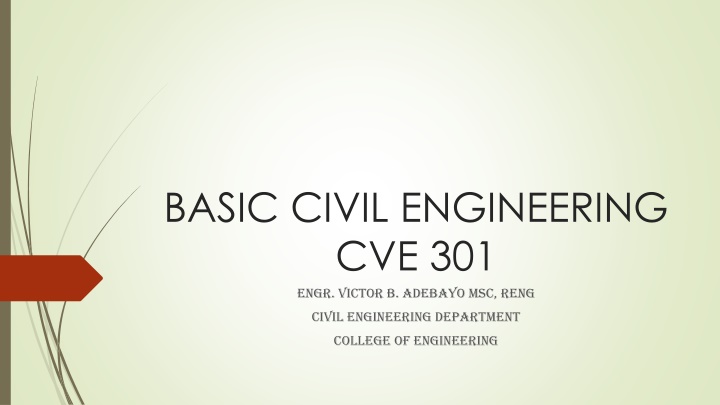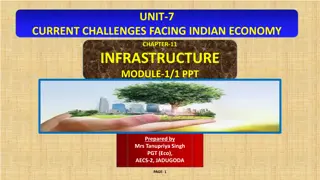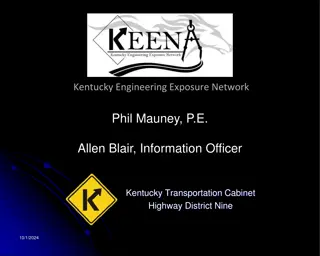Civil Engineering Overview and Infrastructure Development
Civil Engineering encompasses various specialties including site investigation, contractor's plant management, earthworks, roadwork, bridges, tunneling, marine works, and more. It plays a crucial role in infrastructure development for economic growth, urban planning, and addressing housing needs in both urban and rural areas.
Download Presentation

Please find below an Image/Link to download the presentation.
The content on the website is provided AS IS for your information and personal use only. It may not be sold, licensed, or shared on other websites without obtaining consent from the author.If you encounter any issues during the download, it is possible that the publisher has removed the file from their server.
You are allowed to download the files provided on this website for personal or commercial use, subject to the condition that they are used lawfully. All files are the property of their respective owners.
The content on the website is provided AS IS for your information and personal use only. It may not be sold, licensed, or shared on other websites without obtaining consent from the author.
E N D
Presentation Transcript
BASIC CIVIL ENGINEERING CVE 301 ENGR. VICTOR B. ADEBAYO Msc, Reng CIVIL ENGINEERING DEPARTMENT COLLEGE OF ENGINEERING
COURSE MODULES/SYNOPSIS Introduction: The meaning of Civil Engineering. Civil engineering and its various specialties. Site investigation, objective of site investigation, classification of rocks and soils, site organization, geophysical survey and techniques. Contractor s plant: Management plant, concreting plant, pile driver plant, crane and hoist, compressed air plant, bituminous mixing plant, pumps and dewatering equipment. Earthworks, general considerations and planning, site consideration, ground conditions, excavation; bulk, rock, trench and embankment. Ground water control and methods. Roadwork, Bridges, Subways andAirfield construction. Tunneling and underpinning, piling, diaphragm and retailing wall systems, vibro- replacement and vibro-compaction. Marine works; Cofferdams, Caissons, under water foundation construction, sea walls, docks, jetties, dredging and reclamation. Revision and preparation for Examination.
INTRODUCTION TO CIVIL ENGINEERING Civil engineering which is growing right from the stone-age civilization. American Society of Civil Engineering defines civil engineering as the profession in which mathematical and physical sciences gained by study, experience and practice is applied with judgment to develop economically the materials and forces of the nature for the progressive well-being of man. Engineering is the oldest branch of knowledge of the ways to utilize
CIVIL ENGINEERING INFRASTRUCTURE PROJECTS The world has realized that a government should not involve itself in production and distribution but develop infrastructure to create an atmosphere for economic development. Civil Engineering activities in the infrastructure development are as under:
1. A good planning of towns and extension areas in the cities is required. Each should be self-sufficient accommodating educational institutions, markets, hospitals, recreational facility and residential accommodations extension area in offices,
2. Fast rate of urbanization and increase in the cost of land has forced civil engineers to go for vertical growth in cities. In metropolitan cities, 25 storey buildings have become common. Even in small towns multi-storey buildings have become necessity. These requirements have brought in new building technologies and sophisticated analysis methods. Civil Engineers have to solve the problems of rural areas and poor people also. Low cost housing is the need of the day to make poor people afford their own houses.
3. Water is an important need for all living beings. Civil engineers have to exploit various water resources and ensure water supply to urban areas throughout the year. Rural areas need water for agriculture also. Hence civil engineers have to build dams and tanks and bring water to houses through pipes, and to fields through canals and distributories. 4. Another important amenity that public require is good roads. Design of appropriate base course thickness, finishing surfaces, cross drainage, design of horizontal and vertical curves are the duties of civil engineers. Proper design of intersection of roads is necessary. Construction of culverts, bridges and tunnels became part of road works. Railway is an important long distance facility. Construction of railway lines and railway station is an important infrastructure activity. Globalization has resulted in need for building airports and harbours also. 5. Other important infrastructural activities of civil engineering are controlling air pollution, noise pollution and land pollution.
ROLE OF CIVIL ENGINEERS A civil engineer has to conceive, plan, estimate, get approval, create and maintain all civil engineering infrastructure activities. Civil engineer has a very important role in the development of the following infrastructures: 1. Measure and map the earth s surface. 2. Plan and develop extensions of towns and cities. 3. Build the suitable structures for the rural and urban areas for various utilities. 4. Build the tanks and dams to exploit water resources. 5. Build river navigation and flood control projects.
ROLE OF CIVIL ENGINEERS 6. Build canals and distributaries to take water to agricultural fields. 7. Purify and supply water to needy areas like houses, schools, offices etc. 8. Provide and maintain communication systems like roads, railways, harbours and airports. 9. Devise systems for control and efficient flow of traffic. 10. Provide, build and maintain drainage and waste water disposal system. 11. Monitor land, water and air pollution, and take measures to control them. Fast growing industrialization has put heavy responsibilities on civil engineers to preserve and protect environment.
BASIC AREAS IN CIVIL ENGINEERING Civil engineering is a very vast field. It can be classified into: Surveying Construction engineering Structural engineering Earthquake engineering Geotechnical and foundation engineering Quantity surveying Fluid mechanics
BASIC AREAS IN CIVIL ENGINEERING Irrigation engineering Transportation engineering Environmental engineering Town planning Infrastructural development Project management Remote sensing
IMPORTANCE OF AN INTERDISCIPLINARY APPROACH Infrastructure facility includes suitable electricity supply. Internet and telephones are also desirable features. Educational facility also forms part of infrastructure. The proximity of good primary and secondary schools to residential areas is desirable. Collegiate and professional education also form part of infrastructure of a city. Good health care is a necessity. Good primary health centres, specialized hospitals and clinical facilities add to the infrastructure facilities. If a city/town has good infrastructure, it satisfies a citizen and he contributes to the development activity of the nation well. Many private entrepreneurs start industries and other economical activities. Employment opportunities increase and there is all round development. Hence there is need for civil engineers to interact with the following people and plan the civil engineering infrastructure facilities.
IMPORTANCE OF AN INTERDISCIPLINARY APPROACH Architects and town planners. Electrical engineers. Electronic engineers. Mechanical and automobile engineers. Doctors and health care officers. Educationalists. Municipal officers.
Thus civil engineers should understand importance of an interdisciplinary approach in their planning and construction activities so that there is no complaints from any corner of the society. It should be noted that correcting mistakes is always costly and time consuming. A little bit extra care will avoid such mistakes.
QUIZ (3MINS) What is Civil Engineering? Discuss various civil engineering infrastructures required. Write short notes on: (i) Role of Civil Engineers. (ii) Importance of interdisciplinary approach in the development of infrastructures.
SURVEYING Surveying is the science of map making. To start any development activity, the relative positions of various objects in the area with respect to horizontal and vertical axes through a reference point is required. This is achieved by surveying the area. Earlier, the conventional instruments like chain, tape and levelling instruments were used. In this electronic era, modern electronic equipment like electronic distance meters (EDM) and total stations are used, to get more accurate results easily.























